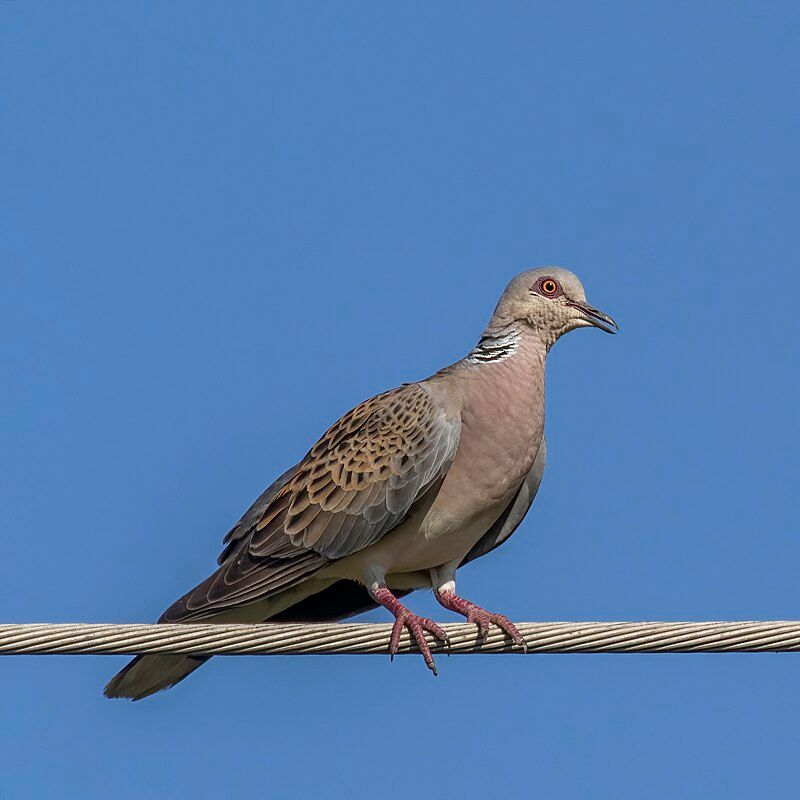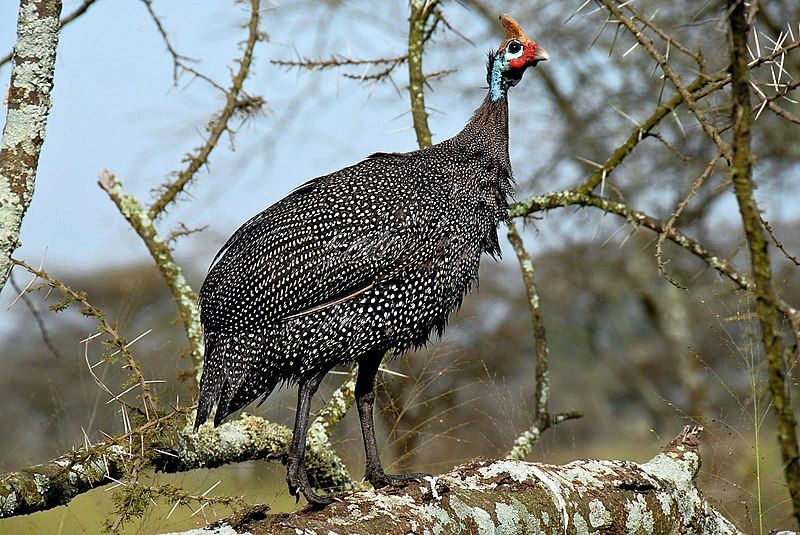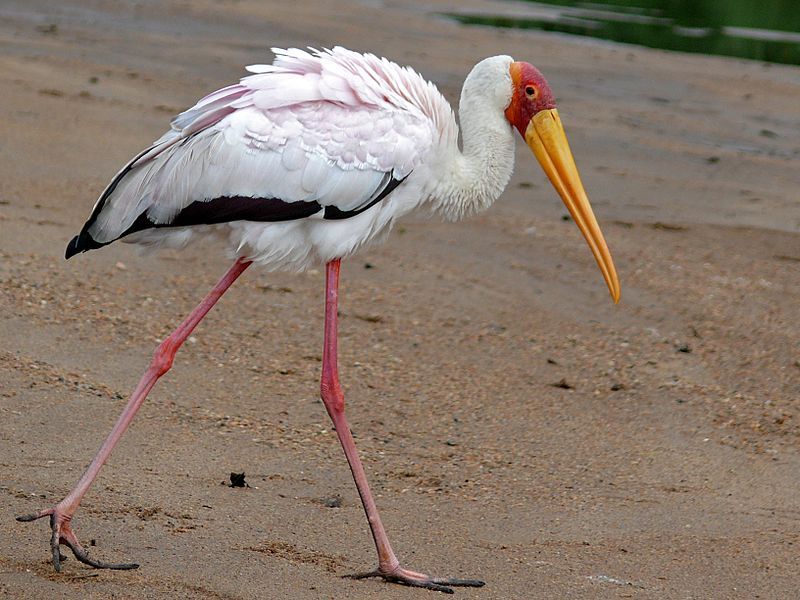Birds are one of the most fascinating creatures found in the Borgu region of Nigeria. With a variety of species, they are a source of beauty and wonder in the diverse landscape.
From the colorful parrots and hornbills to the majestic waterfowl, birds uniquely charm the area. With the lush vegetation, wetlands, and abundance of insects, this region is a haven for birds and a great place to observe them.
Birders from around the world flock to Borgu to explore its rich birdlife. By participating in birdwatching, you can join the community of those passionate about these amazing creatures and help conserve their habitats.
9 Birds to Watch in Borgu
Borgu is a region in West Africa that spans parts of Benin and Niger. It is home to a rich diversity of wildlife, including many species of birds. If you are a birdwatcher or a nature lover, you might want to visit Borgu and see some of these fantastic birds.
Here are nine birds that you can watch in Borgu.
1. European Turtle Dove

The European turtle dove is a medium-sized bird belonging to the Columbidae family, which includes doves and pigeons. It has a wide range of breeding habitats across the southwestern Palearctic region, including countries in North Africa.
During winter, the European turtle dove migrates to northern sub-Saharan Africa. This species is known for its distinctive call, a series of soft cooing sounds.
The bird is usually found in open woodlands and cultivated areas, and it feeds mainly on seeds, other plant material, and insects. Due to the decline in their population, the European turtle dove is listed as vulnerable by the IUCN.
Conservation efforts are underway to protect this species’ habitat and encourage population growth.
| Kingdom | Animalia |
| Phylum | Chordata |
| Class | Aves |
| Order | Columbiformes |
| Family | Columbidae |
| Genus | Streptopelia |
| Species | S. turtur |
2. Cuckoos
Cuckoos are members of the Cuculidae family, the only family in Cuculiformes. This family includes many different species of birds, such as the standard or European cuckoo, roadrunners, koels, malkohas, couas, coucals, and anis.
The coucals and anis are often grouped as their own families, the Centropodidae and Crotophagidae, respectively, because they are closely related.
Cuckoos can be found worldwide, living in various habitats, from forests and grasslands to deserts and wetlands. They have adapted to survive in many different environments and have become one of the most widespread bird families in the world.
| Kingdom | Animalia |
| Phylum | Chordata |
| Class | Aves |
| Clade | Otidimorphae |
| Order | Cuculiformes |
| Family | Cuculidae |
3. Helmeted Guineafowl

The helmeted guineafowl is the most prominent member of the Numididae family, a group of birds commonly referred to as guineafowl. It is the only member of the genus Numida, which is native to Africa, most often being found south of the Sahara desert.
This particular bird species has been domesticated and introduced into many parts of the world, including the West Indies, North America, Colombia, Brazil, Australia, and Europe. The helmeted guineafowl is a medium-sized bird with a distinctive crest on its head.
It has a black and gray speckled plumage and a red wattle on its neck. This bird is omnivorous, meaning that it feeds on a wide variety of plants and animals. The species is highly social and often forms large flocks when it migrates.
The helmeted guineafowl has a long history of being kept on farms and homesteads for eggs and meat. Its eggs are particularly prized, being large, creamy, and protein-rich. This species is also valued for its ability to act as a natural pest control for crops and gardens.
The helmeted guineafowl is an important species that is widely distributed throughout the world. It is highly valued for its utility as a domesticated species, as well as its role in helping to control pests and maintain healthy ecosystems.
| Kingdom | Animalia |
| Phylum | Chordata |
| Class | Aves |
| Order | Galliformes |
| Family | Numididae |
| Genus | Numida |
| Species | N. meleagris |
4. Blue-headed Coucal
The blue-headed coucal is a cuckoo species belonging to the family Cuculidae. It is native to tropical central Africa and is typically found in swamps, river banks, forest edges, and other wet locations.
This bird is easily identified by its distinctive blue-colored head, which stands out amongst the greenish-grey body. The blue-headed coucal is an active forager whose diet consists of small invertebrates, such as insects and spiders, and fruits.
It prefers to hunt on the ground, using its long legs and powerful beak to catch its prey. The blue-headed coucal is a social bird often found in small flocks of up to seven individuals.
During the breeding season, the males compete for mates by engaging in aerial displays, such as swooping and chasing. The nesting season usually occurs during the wet season, and the nests of the blue-headed coucal are typically constructed in trees or shrubs.
The female usually lays two to three eggs, which she will incubate for about two weeks. The chicks are cared for by both parents and fledge after about three weeks.
The blue-headed coucal is an essential species in the tropical forests of Central Africa and plays a vital role in the local ecology.
| Kingdom | Animalia |
| Phylum | Chordata |
| Class | Aves |
| Order | Cuculiformes |
| Family | Cuculidae |
| Genus | Centropus |
| Species | C. monachus |
5. Stone Partridge
The stone partridge is a species of bird belonging to the New World quail family. It is a medium-sized, typically brown bird with a distinctive feature of the upright tail.
It inhabits various habitats, including scrubland and light woodland areas, usually near rocks.
Its range is expansive, spanning from Kenya and Ethiopia to Gambia. The stone partridge is a typically shy bird, which can be challenging to spot in its natural environment. Its primary diet consists of seeds, insects, and other small invertebrates.
During winter, it shifts to a more varied diet of leaves, buds, and other plant matter.
Breeding occurs in the summertime, with the female laying up to 12 eggs in a grass-lined scrape on the ground. The stone partridge is a unique and interesting species, with its distinctive upright tail and wide-ranging habitat.
Despite its wide range, it remains a relatively uncommon species and is one of the least studied birds in the New World quail family.
| Kingdom | Animalia |
| Phylum | Chordata |
| Class | Aves |
| Order | Galliformes |
| Family | Odontophoridae |
| Genus | Ptilopachus |
| Species | P. petrosus |
6. Great Spotted Cuckoo
The great spotted cuckoo is a species of bird that belongs to the Cuculiformes order. This order consists of birds such as roadrunners, anis, and coucals. The great spotted cuckoo is abundant in Africa and the Mediterranean Basin.
It can lay its eggs in the nests of other birds, mainly those belonging to the corvid family, such as the Eurasian magpie.
This behavior, known as brood parasitism, is an evolutionary strategy that helps the great spotted cuckoo reduce its workload of incubating and caring for its offspring. The cuckoo lays its eggs in the host’s nest, so the host unknowingly raises the cuckoo’s young.
This gives the cuckoo more time to find food and other activities while the host unknowingly devotes energy to raising the cuckoo’s young.
| Kingdom | Animalia |
| Phylum | Chordata |
| Class | Aves |
| Order | Cuculiformes |
| Family | Cuculidae |
| Genus | Clamator |
| Species | C. glandarius |
7. Black-throated Coucal
The black-throated coucal is a type of cuckoo bird that is found in West Africa. This species typically resides in second-growth forests near the forest’s edge and in grassy swamps.
It is a subspecies of the coucal found in northern and central Zaire that is sometimes classified as its species, Neumann’s. This species is distinct from the other coucals, as it has a unique black throat.
It is also smaller than other coucals and typically feeds on small insects, lizards, and frogs. In addition to its distinct black throat, the black-throated coucal has a bright yellow eye and a white-tipped tail.
This species is a shy bird rarely seen in the open, preferring to remain hidden in dense vegetation.
| Kingdom | Animalia |
| Phylum | Chordata |
| Class | Aves |
| Order | Cuculiformes |
| Family | Cuculidae |
| Genus | Centropus |
| Species | C. leucogaster |
8. Great Blue Turaco
The great blue turaco is a large bird species belonging to the Musophagidae family. This bird species stands out due to its impressive size, which is between 70 and 76 cm long.
Its plumage is primarily grey-blue and is further highlighted by an upright crest of blue-black feathers, which can reach up to 10 cm high. Both male and female turacos have similar plumage, making distinguishing them difficult.
The great blue turaco is a majestic bird and a beautiful sight.
| Kingdom | Animalia |
| Phylum | Chordata |
| Class | Aves |
| Order | Musophagiformes |
| Family | Musophagidae |
| Genus | Corythaeola |
| Species | C. cristata |
9. Yellow-billed Stork

The yellow-billed stork is a large species of wading bird found in many parts of Africa south of the Sahara, as well as on the island of Madagascar. It is part of the Ciconiidae bird family, including many other large stork species.
The species is sometimes referred to as the wood stork or wood ibis due to its preferred habitat of wetlands and woodlands. The yellow-billed stork is a distinctively tall bird with a long neck, a large bill, and long legs.
It is usually grayish-white, with darker wings and a yellow bill.
Its wingspan can reach up to 5.5 feet, and it stands up to 1 meter tall. The yellow-billed stork is a voracious feeder and can often be seen wading in shallow waters, searching for small fish, frogs, and other aquatic creatures.
It will also take advantage of opportunities to feed on carrion and sometimes follow farmers, waiting for them to harvest their crops and taking advantage of the exposed insects and small rodents.
The species is usually found in small groups, though during the breeding season, they will often gather in large flocks to nest. The birds typically build their nests in trees, often in the company of other large stork species.
They are monogamous and usually return to the same nesting site each year. The yellow-billed stork is listed as a species of most minor concern by the IUCN, meaning it is not considered at any immediate risk of extinction.
However, the species is still vulnerable to habitat destruction and human disturbance. Protecting its habitats and ensuring its population remains healthy is essential.
| Kingdom | Animalia |
| Phylum | Chordata |
| Class | Aves |
| Order | Ciconiiformes |
| Family | Ciconiidae |
| Genus | Mycteria |
| Species | M. ibis |
Conclusion
Birds are an essential part of Borgu’s environment and culture. They symbolize beauty and freedom, providing a necessary food source and income for many locals.
Furthermore, they play a vital role in maintaining biodiversity, as they help disperse seeds and pollinate plants.
It is clear that birds are an integral part of life in Borgu, and efforts should be made to protect them and their habitats.